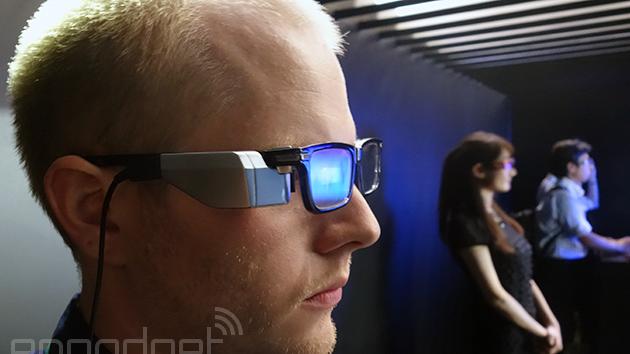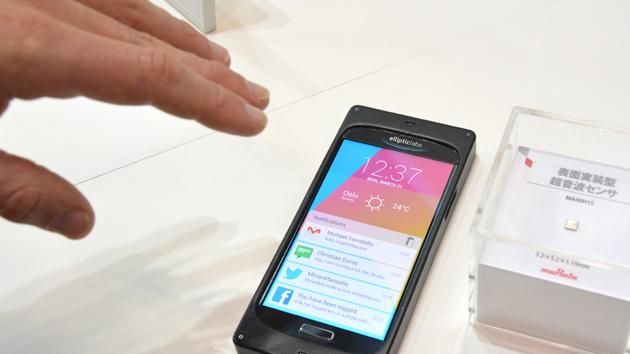ceatec2014
Latest

Sayonara, CEATEC 2014: Another curious tech show
Japan's annual CEATEC is often the black sheep of the global tech show circuit. While CES in Vegas throws up new TVs, laptops, tablets and the occasional phone to pore over, and IFA in Germany does the same in the middle of the year, CEATEC doesn't usually offer up many big ole' fashioned product launches. Whether it's due to the nation's gradually recovering economy, or strategic choices of Japanese companies (Sony's not here, to start), the trade show tries to balance major Japanese tech brands alongside carmakers like Honda and Toyota, as well as component manufacturers, universities and tiny startups trying to gain a foothold. It's a generally messier show, but then that's part of the charm: There are always some interesting things to see -- as you'll discover for yourself below. (And you can find the rest of our reports right here.)

Honda's latest robotic stool is fun to ride, still impossible to buy
One of the several reasons for why we love CEATEC is that we get to test ride human transporters there (as well as meeting robots of all sorts). Last year we came across Honda's stool-like UNI-CUB, and this year, the company is back with a new and improved model dubbed UNI-CUB Beta, and it even let attendees ride the vehicles -- while wearing Epson's smart glasses, no less -- around the show floor under staff supervision. It should be noted that the Beta was actually first unveiled at the Tokyo Motor Show last November, but that didn't kill our curiosity. Read on for our impression and hands-on video.

Let this shape-shifting baton escort you around town
Don't you hate it when you have to constantly check your phone for map navigation, thus not able to fully enjoy the scenery while travelling? Rather than just switching to audio navigation (which can get annoying after a while), NTT Docomo believes tactile feedback is another possible solution, as demonstrated by its Yubi Navi ("Yubi" meaning finger in Japanese) concept at CEATEC. As you can see in the above GIF image, this simple handheld device can gently twist left and right to give turn directions to your thumb. But there's more: When paired with another Yubi Navi, the two users can simulate the feeling of holding hands by squeezing their own devices, as the lower part of the stick can push a bump up against the palm.

The Tempescope shows you tomorrow's weather by physically creating it
Another very cool item hidden within CEATEC, Japan's biggest tech show, was the Tempescope. The team behind it call it "an ambient physical display that visualizes the weather, inside your living room" -- it's an elaborate lit-up box that shows you tomorrow's weather in a very classy, oddly relaxing, way. To work out exact what kind of weather it should summon, the Tempescope pulls hourly forecasts from a wireless connection from a PC (future models could pretty easily pluck similar information from your smartphone), and once the 'scope knows what's happening, it'll try to create those meteorological conditions inside the sealed cuboid you see above. A combination of water and ultrasonics creates the cloudy vapor inside the box, while water can also be gathered at the top, and dripped down to create rain. LED lights at the top attempt offer up an estimation of either thunder or sunshine, depending on what's going down tomorrow.

Toshiba prototype is a simpler, lighter Google Glass rival... with a catch
Nearly every tech company wants in on the wearables game, but they can't all be Google Glass or Apple Watches -- not that they have to be. But hey, here's Toshiba -- and it's got a Toshiba Glass prototype to show off. We'll say this right at the start: this remains a reference product that the company's showing off at CEATEC in Japan this week. And yes, technical specifics (let alone a price) aren't being discussed yet, but the vision for Toshiba's eye-based wearable prototype is a gentle, predictable one. The hardware is the combination of a tiny projector, attached to admittedly normal-looking frames. However, there's actually a special kind of one-sided reflective glass to catch the projection. The projection module itself is kind of bulky, but actually lightweight... which is great, until you realize that this prototype requires a constant wired connection to work.

The one (gesture control) ring to rule them all
While many companies are tinkering with lasers, ultrasound and even arm muscles for touchless gesture control on portable devices and desktop PCs, Japan's 16Lab just wants to put a pretty ring on you. The yet-to-be-named titanium wearable is designed by the award-winning Manabu Tago, and it features ALPS Electric's tiny module (5.05 x 5.65 x 2.5 mm) that somehow manages to pack Bluetooth Smart radio, movement sensor, environment sensor plus antennas -- there's a video demo after the break. Despite its custom-made 10mAh lithium polymer cell, 16Lab is aiming for at least 20 hours of battery life. This is possible mainly because you have to place your thumb on the top pad (with the ring's wedge pointing away from the user) to enable the sensors -- upon which point the ring vibrates to confirm that it's active. It's then just a matter of waving and tilting your hand until you're done.

I played ping pong with a robot and it went easy on me
No, this isn't the Tokyo Game Show. OMRON, the alleged company behind Amazon Fire's face-tracking feature, exhibited its ping pong robot at CEATEC just to demonstrate its automation prowess. Well, by robot we don't mean the humanoid kind; it's more of a large silver crane that swings a bat with three arms. It even has a stationary head that looks down upon its human challenger (including this author, as shown in the video after the break); that's where all the sensors are stored in order to track the player and the ball. The brain, on the other hand, is tucked into a cabinet next to the robot. Update: We managed to get a rematch with the robot, and you can watch it in our new video after the break.

We just had an out-of-body experience with this robot-Oculus project
It's an unusual experience for a weekday afternoon: I stare up to see myself, staring up. I'm strapped into an Oculus Rift VR headset, which is both controlling (and streaming from) cameras atop a 1.5ft robot roaming around my feet. This robot on wheels is composed of segments that hold a stereo camera, storage, the "brains" and, importantly, a wireless internet connection to stream dual camera feeds to a nearby PC -- as well as receive movement instructions. The effect, courtesy of high-latency motion feedback from the Rift, is that when I turn to the right, or look upwards, the robot does exactly the same thing, with a motorized joint connected to the camera module matching my gaze.

At last, phones will get ultrasound gesture control in first half of 2015
We've been following Elliptic Labs' development on ultrasound gesture control for quite a while, but no time frame was ever given until now. Ahead of CEATEC in Tokyo, the company finally announced that its input technology -- developed in partnership with Murata -- will be arriving on phones in the first half of 2015. But that's not the only good news: On top of the usual swiping gestures for images, games and navigation (we saw some of this last year), there's now a new capability called "multi layer interaction," which uses your hand's proximity to toggle different actions or layers. It's potentially useful for glancing at different types of messages on the lock screen, as demoed in the video after the break.

Murata's cheerleader robots move around on balls and do it in J-Pop unison
It's probably the most Japanese thing I've seen in my first year of covering the country for Engadget: Robo-cheerleaders, barreling around in sync like some sort of Japanese girl "idol" group. In total, there are 10 Cheerleader bots (with two standby units), with light-up cheeks, pom-pom arms that look like PlayStation peripherals and glowing eyes. They glow; they lift their arms; they form ensemble shapes; and they are arguably the most adorable, Weeble-esque robots you've ever laid eyes on. Following the bicycling Murata Boy and the unicycling Murata Girl, here's the Murata Cheerleader and her nine sisters. They're about to dance in formation, all while balancing on a ball. Not only because they simply can, but also because this is how their parent company showcases its (often mind-numbing, let's admit it) sensors and components to both businesses and Joe Public alike.

